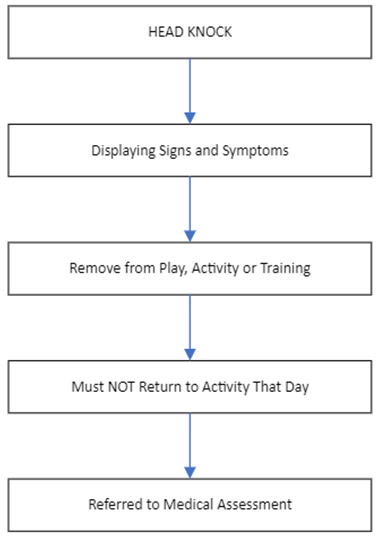Definition
Head injury is any trauma to the scalp, skull or brain resulting from direct or indirect force to the head, face or neck or from anywhere else in the body where force is transmitted through the head. Management of a head injury depends on its severity. You must consider how the injury was sustained when assessing and managing a head injury; any loss of consciousness is an important factor. Refer to the next page for symptoms of a head injury.
On campus
- Call the Health Centre, 9442 1700/0412 744 192 and have the student escorted to the Health Centre for assessment.
Off campus (e.g. excursion, off-campus sport training, Friday or Saturday sport, or any other school sporting fixture)
The team coach/manager, excursion organiser/staff member must:
- As soon as practicable refer the injured student to the nearest first aid post or medical facility for If in doubt, call an ambulance 000. Complete incident report for head injury.
- Report/handover must be to another adult who has a duty of care for the student i.e. the parent/s of the student, the Health Centre staff, Year Group Co-ordinator or the Director of Residential Community (Boarders) with a verbal explanation of the injury accompanied by any written
- Ascertain at handover that the student will be monitored for any changes in his condition and is taken to a medical practitioner for assessment as soon as possible.
- The medical report must be provided to the Head of House/Director of Sport/Classroom Teacher (Prep School).
- If a concussion is diagnosed the student must be managed as per the Management of Concussion Injuries Guidelines.
A medical clearance is required to return to full contact training/sport 14 days post cessation of symptoms. Where practicable, this clearance should be provided by the same medical practitioner who determined the original diagnosis of concussion.
Return to full competition not before day 21 post concussion AND must have remained symptom free for at least 14 days.
Symptoms of a Head Injury
Most head injuries are not serious but occasionally they can result in damage to the brain. It is recommended that you seek medical attention immediately if any of the following develop as a result of trauma to the head.
|
|
|
|
|
|
|
|
|
|
|
|
|
|
|
|
|
|
|
|
The Concussion Recognition Tool 6 (CRT6) is a simplified summary of the key signs and symptoms and ‘red flags’ that should raise a concern about a possible concussion. 20 symptoms in the CRT6 are listed above.
The CRT6 may be used as an aid to the on field recognition of concussion. If any of the visible clues (signs) or symptoms are present following an injury, the individual should be assumed to have concussion and must be immediately removed from play or training and must not return to activity that day. “If in doubt, sit them out”.

